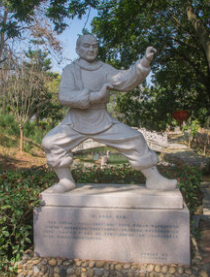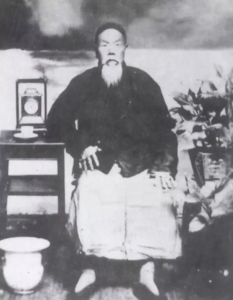Huzun Quan (虎尊拳, Tiger Respecting Boxing), also known as Huxing Quan (虎形拳, Tiger Boxing) and Yongfu Huzun (永福虎尊, Yongfu County Tiger Boxing) is the traditional Tiger boxing method of Fujian province. It is one of the oldest known styles for which the clawing and powerful methods of Tiger have been influenced from. It is sometimes thought to be the forerunner of the Southern Guangdong styles such as Hung Gar and of the Karate system known as Uechi Ryu. There are many Southern Tiger Systems that have since developed, Yongfu Tiger Boxing is possibly the parent/ancestral style of many of them and it is the most Tiger-centric martial art in China.
Huzun Quan is rare outside of China. The style originated in Yongfu (Now known as Yongtai Country, Fuzhou, Fujian Province China) and is thus why it is also called Yongfu Tiger Boxing. It is a powerful and aggressive martial art which focuses on unrelentingly attacking often maiming opponents with smashing, ripping blows.
Early Fujian Southern Boxing
The southern boxing styles of Fujian have their earlier records to the Southern Song Dynasty. One of the earliest exponents Zhang Ciguan, was said to have practiced the ancient skills of Niu Fa (Cow method) and Hou Fa (Monkey method) in a Daoist sanctuary in YongTai Mingshanshi.
In 1176, three daoist disciples Zhang Ciguan, Xiao Faming and Lian Zhongqiang travelled to Longhushan (Dragon Tiger Mountain, in neighbouring Jiangxi Province – The origin of ‘religious’ Daoism) to study Daoism under the Zhang Tianshi (Heavenly Celestial Master Way). They also wandered around the provinces of Jiangxi, Zhejiang and Fujian. Then they returned to reside and teach in the Mingshanshi. Later Southern styles were also developed and thus the foundation for Fujian martial arts were formed. In Yongfu areas there was a large influence from these teachers and their boxing methods became known collectively known as Jishan Quan (Integrated Mountain Fists).
Origins of Yong Fu Huzun Quan (永福虎尊拳, Yong Fu Tiger Boxing)

Tiger Style (虎尊拳) was founded in Fujian by Li Yuan Zhu (李元珠, est.1716-1793) from Fukou in Yongfu (today Fuqing, Fujian province). With a basis in boxing of Jishan Quan, after years of practice during his mid years he developed a powerful system of martial arts based on the spirit, strategy and concept of the Tiger which were found in the mountainous area. “Zun” (Respect) was addded by later generations to the name of the style for two reason. Firstly since in China the Tiger is king of all beast it should be respected. Secondly, because the training in the style is so difficult and demanding then the method should be respected thus in general, those who only practiced the style would simply refer to it as Hu Quan, whilst those who inherited and taught would use Huzun Quan .
Li Yuan Zhu had taught two well known disciples, Zheng Deng Guang (郑登光, est.1766-1818 ) and Li Zhao Bei (李昭北, est.1761-1827 ). It is said that Zheng inherited the essence of the tiger’s kicks “Hu Tui” and Li that of the Tiger’s Claws “Hu Zhua”. Whether the powerful tiger claws that would destroy opponents like Li’s Meng Hu Qin Yang (Fierce tiger catches goat) or the powerful kicks that had opponents down in not time, such as Zheng’s San Hu Wei Tui “3 Tiger Tail Kicks” both of which could be deadly.
There is a famous story told in Fukou that speaks of a day when Li Yuanzhu had asked his disciples to demonstrate their skills. Zheng Dengguang was said to have kick one of the large wooden pillars of the hall which shifted the pole from the stone on which was lodged by a few centimetres. Then Li Zhaobei attacked the same pillar with his fierce tiger claw which left deep marks imprinted. These remnants remain in the old hall on Fukou until this day. The two Masters Li Zhaobei and Zheng Dengguang then spread Huzunquan around the Yongtai region and beyond.

Zheng Bu Su (also known as Zheng Xianji (郑仙纪, 1854-1929)) was one of the most famous masters (5th Generation) who opened a school in Fuzhou and had taught many disciples however many became associated with the Taiping Tianguo uprisings and during the tme Zheng Xianji reduced his teachings in favor of conducting revolutionary activities.
In his later years, the most well known disciples was Zhou Zi He (周子和, one of the famous fighters of Fuzhou). Zhou Zi He mastered many systems of Fujianese martial arts but his most favoured was that of Tiger Style. There is common legend/story that Zhou (sometimes it was Zheng Xianji, with Zhou as his older martial brother) accepted a Japanese student who went on to be the founder of Uechi Ryu style Karate.
Lin Wenhua (林文华) was one of the most well known masters in the mid to late 1900’s, gaining fame from a young age by his achievements in a 1938 Leitai event. He continued his practices and became renowned for his Huzun Quan. After liberation he taught many students such as Zheng Yuyuan and Tan Rudian. Many of his lineages brought Huzun Quan beyond China such as Malaysia and Singapore.
Zheng Deng Guang had taught only a few and nowadays most of Yongtai practices the Li Zhaobei method. Descendants of Zheng had also taught the Gan Family (descendants of Imperial Gan Baoguo) who then propagated the style in the Pingnan county area of Fujian, for generations the style was taught to Gan Family members and led to Pingnan becoming also famous for the Huzunquan Style. Currently up to the 8th generation, masters such as Gan Boen, Gan Daisong, Gan Jiutong and Gan Fuxiong carry on the tradition.
Huzunquan was influential on many styles within Fujian but also in neighbouring provinces such as Zhejiang, Jiangxi and Guangdong.
Principles
Huzunquan (Tiger Boxing) is based on the fierceness and ruthlessness of the tiger, motions are powerful heavy and destructive. In addition to direct powerful striking, the style also emphasises clawing, locking and trapping methods including Chin-na and associated Dian Xue(Vital Point attacking). A basic notion in the style is that of the 6 harmonies:
- Shen [Body] (inlcuding tendons, bones, skin) that covers all manifestations of the body including all the joints, and sinews.
- Ben Shou [ Basic Hands] these are manifestation of power through the limbs by the associated joints and components.
- Ma [Horse] represents all stance and footwork methods. In stillness like a rock in motion light and nimble.
- Jing [Essence] : The vitality of life that shoud be conserved and promoted through nourishment.
- Qi [Energy] : The internal energy supporting all movements, the development and nourishment of that energy
- Shen[Spirit] :The vitality and manifestation of the spirit through the doors such as the eyes.
Another feature of Huzunquan and of fujian martial arts in general are the comprehension of the 5 elemental hands and the supporting requirements of the 4 methods. Hu Jing (虎经, Tiger Power) is a description of the type of power manifested by a Huzunquan practitioner. The most fundamental jing manifestation is that of understanding jing (Dong Jing) and listening jijng (Ting Jing) which are prerequisites to developing Hu Jing. With Hu Jing it is the transmission of all power concentrated into a particular component or surface of attack. Hu Jing in its true manifestion is like a tidal wave which is seen, felt even understood but it cannot be stopped by a single individual its power would surpass anything withstanding it and destroy it with a single strike. Huzunquan truly believes in a single strike kill philosophy.
Gong Fa (功法练习, Power/Skills Training)
The most important aspect of training in Huzunquan is known as Gong Fa (Power/Skill Methods) as it provides the strengthening (both internal and external) and skills that form the foundation for the effective use of the techniques in the style. Without the skill training Huzunquan would be empty for the power is the most fundamental of all the learnings of the style. Some of the methods include:
- Zhanzhuang (Post standing exercise)
- Yuanqi (the qigong training)
- Zhishou (branch hands, including single and double practices)
- Da Shabao (Striking sandbags)
- Wuwushi (Practice with rocks and stones)
- Wushisuo (practice with the stone locks)
- WuTiedadao (exercises with heavy iron rods or long handled knife)
- Chayong (piercing practices for the fingers)
- Zhua Jiutan (grabbing liquor jugs/pots for the exercises of grips
- Da Muzhuan (Striking the wooden dummy) and more.
Originally, Gong fa was practiced for a few years prior to learning techniques and in the past the strengthening combined with San Zhan/San Jian would be all that a student would learn for three years daily. The development of the Gongfa then proceeds alongside the technical and training of the very many drills of the style.
Quan fa (拳法练习, Techniques Training)
There are many basic methods in addition to the Gong Fa (Skill Training) which we practice individually that help to mould body structure, power and of course technique. Some of these include:
| Er Hu Pu Shi (Hungry Tiger Pounces on Prey) Meng Hu Qin Yang (Fierce Tiger Holds Goat) Ba Xian Zhang (8 Immortals Palms) Lian Zhu Chui (Continuous Pearls Strikes) Hei Hu tao Xin (Black Tiger Rips out the Heart) Ri Yue Jiao (Sun Moon Kick) | Li Pi Hua Shan (Splitting Mt Hua) Ye Hu Chu Lin (Night Tiger Exits Forest) Huang Niu Tiao Jiao (Yellow Ox Incite Clash) Lao Hu Xi Lian (Old Tiger Washes Face) Meng Hu Xi Zhua (Fierce Tiger Cleans Paws) Guan Gong La Xu (Kwan Kung Strokes Beard |
Quan Tao (拳套练习, Boxing Routines/Forms Training)
The study of forms are basically to introduce progressively more techniques into the student’s arsenal. In Huzunquan, the number of forms are historically many but since they are not as important as the other features of the style which are power and combat orientated, many of the sets have been lost as many masters practice only a few key ones. Each set introduces the practice of new techniques and as a result are often named after the key techniques which it emphasizes. Forms in Huzunquan are not long (about 30 techniques on average) and they are movement wise simple, however to train and practice properly with the right skill and Hu Jing is very difficult. Some of the most common sets are:
| 三箭 3 Arrow 双箭 Twin Arrows 剪手 Scissor Hands 四门 4 Doors 三十六手 36 Hands 千字打 Character ‘千’ Striking | 猛虎洗爪 Fierce Tiger Cleans its claws 虎仔伸腰 Fierce Tiger extends the waist 猛虎下山 Fierce Tigers Descends the Mountain 猛虎探爪 Fierce Tigers Stretches Claws/Paws 猛虎过港 Fierce Tigers passes the guarded post 猛虎出林 Fierce Tiger exits the forest 猛虎出洞 Fierce Tiger Exits the Cave | 太子游城 Young Prince roams the city 日月连环脚 Sun Moon continuous kicks 扑地虎 Pouncing on the ground Tiger 关公拉须 Kwan Kung Strokes Beard 关公抱刀 Kwan Kung Holds Knife 关公拖力 Kwan Kung Drags Force 老虎洗脸, Old Tiger Cleans head |
Combat Sets
- 双虎跌 Double Pouncing Tigers
- 两虎相斗 Two Tigers Battle
- 对产 2 Man Trident
Weapons
- Ba Gua Gun (八卦棍 Bagua Staff)
- Liu Zhuang Gun (六桩棍 6 Posts Staff)
- Qi Mei Chan (齐眉棍 Eyebrow height trident)
- Mao Jia Cha (笔架叉 Brush Structured Trident)
- Mei Hua Gun (梅花棍 Plum Blossom Staff)
- Lang Ba (狼宪 Wolf Club)
- San Cha Chui (三叉槌 3 Point Tiger Fork)
- Lu Xing Bang (驴形棒 Deer Staff)
- Ban Deng (板凳 Bench)
